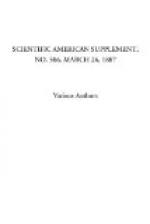NO ELECTRICITY FROM THE CONDENSATION OF VAPOR.—It has been maintained by Palmieri and others that the condensation of vapor results in the production of an electrical charge. Herr S. Kalischer has renewed his investigations upon this point, and believes that he has proved that no electricity results from such condensation. Atmospheric vapor was condensed upon a vessel coated with tin foil, filled with ice, carefully insulated, and connected with a very sensitive electrometer. No evidence could be obtained of electricity.—Ann. der Physik und Chemie.
* * * * *
THE ELECTRO-MAGNETIC TELEPHONE TRANSMITTER.
An interesting contribution was made by M. Mercadier in a recent number of the Comptes Rendus de l’Academie Francaise. On the ground of some novel and some already accepted experimental evidence, M. Mercadier holds that the mechanism by virtue of which the telephonic diaphragms execute their movements is analogous to, if not identical with, that by which solid bodies of any form, a wall for instance, transmit to one of their surfaces all the vibratory movements of any kind which are produced in the air in contact with the other surface. It is a phenomenon or resonance. Movements corresponding to particular sounds may be superposed in slender diaphragms, but this superposition must necessarily be disturbing under all but exceptional circumstances. In proof of this view, it is cited that diaphragms much too rigid, or charged with irregularly distributed masses over the surface, or pierced with holes, or otherwise evidently unfitted for the purpose, are available for transmission. They will likewise serve when feathers, wool, wood, metals, mica, and other substances to the thickness of four inches are placed between the diaphragm and the source of vibratory movement. The magnetic field does not alter these relations in any way. The real diaphragm may be removed altogether. It is sufficient to replace it by a few grains of iron filings thrown on the pole covered with a piece of pasteboard or paper. Such a telephone works distinctly although feebly; but any slender flexible disk, metallic or not, spread over across the opening of the cover of the instrument, with one or two tenths of a gramme (three grains) of iron filings, will yield results of increased and even ordinary intensity. This is the iron filing telephone, which is reversible; for a given magnetic field there is a certain weight of iron filings for maximum intensity. It appears thus that the advantage of the iron diaphragm over iron filings reduces itself to presenting in a certain volume a much more considerable number of magnetic molecules to the action of the field. The iron diaphragm increases the telephonic intensity, but it is by no means indispensable.
* * * * *




